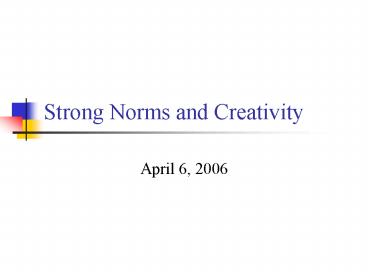Strong Norms and Creativity - PowerPoint PPT Presentation
1 / 18
Title:
Strong Norms and Creativity
Description:
Does conformity pressure stifle creativity or can it be used to increase creativity in groups? ... in individualistic groups value individualistic behavior ... – PowerPoint PPT presentation
Number of Views:36
Avg rating:3.0/5.0
Title: Strong Norms and Creativity
1
Strong Norms and Creativity
- April 6, 2006
2
Ongoing Debate
- Does conformity pressure stifle creativity or can
it be used to increase creativity in groups? - Q1 Are there norms that enhance group
creativity? - Q2 Can creating pressure to conform to these
norms increase creativity in groups?
3
Norms for Creativity?
- Collectivism Groups bind and mutually
obligate individuals. - Individualism People are independent and
self- determining (Oyserman, et.al.,
2002) - Collectivistic values are beneficial
- Collectivism promotes cooperation and reduces
social loafing (Wagner, 1995) - Collectivism promotes identification with the
organization (Chatman, Polzer, Barsade Neale,
1998)
4
Hypothesis 1 Individualistic groups will have
higher performance than collectivistic groups on
creativity tasks.
- People in collectivistic cultures are more
conforming. (Bond Smith, 1996) - Given that creative ideas are initially deviant
increasing conformity pressure will limit
creativity (Moscovici, 1985 Nemeth Staw,
1989). - Willingness to stand out from the group and to
confront differences will promote creativity in
individualistic groups. - (Stasser, 1987 Nemeth, et al, 2001)
5
Summary of Results (Goncalo Staw, 2006)
- Instructions to be creative stimulate greater
creativity in individualistic groups than
collectivistic groups. - More ideas, more diverse ideas, more creative
ideas. - Individualistic groups are more creative even at
the selection stage which is a convergent task. - Selected ideas more creative and multi-faceted.
- Notion that collectivistic groups can be more
creative than individualistic groups when
instructed to be was not supported.
6
Study 2 Role of Conformity Pressure (Goncalo
Duguid, 2006)
- Research Question
- If individualistic norms increase creativity
relative to collectivistic norms, then will
pressure to conform to norms that are
individualistic also stimulate creativity?
7
Conformity in Individualistic Cultures
- Conformity
- In US standing out and being different is
positive and expected but in China it is rude
and childish. - Accountability makes individualists more
competitive and collectivists more cooperative. - People in individualistic groups value
individualistic behavior even though such
behaviors do not benefit them.
8
Hypothesis
- Since individualistic norms are beneficial for
creativity, groups are more likely to realize the
benefits of individualism when such norms are
strong as opposed to weak.
9
Method
- Subjects 180 Cornell Undergraduates
- N 60 groups of 3.
- Design 2 Strength (Strong vs. Weak) x 2 Content
(Individualistic vs. Collectivistic) - Phase 1 Norm content and strength
manipulated. - Phase 2 Group creativity measured with a
brainstorming task.
10
Experimental Manipulation
- Individualism-Collectivism Manipulation
- Team building task Success attributed to each
individual or to the group as a whole. - Strong-Weak Norms Manipulation
- Biased Questionnaire
- (1) Give 3 reasons why a group should
(encourage/allow) it members to (agree/disagree)
with one another - (2) Give 3 reasons why a group should
(accept/reject) people who do not fit with the
group
11
Measures of Creativity
- (1) Sheer number of ideas generated.
- (2) Diversity of ideas generated
- (3) Independent rating of each idea on a scale
of 1 (Not at all creative) to 5 (Highly
Creative). - (4) Number of creative ideas (above 3)
- (5) Creativity of idea selected by the group
12
Results Idea Generation
13
Results Idea Diversity
14
Results Independent Ratings of
Creativity
15
Results Number of creative ideas
16
Results Creativity of selected idea
17
Study Conclusions
- Norms can be used to influence creativity,
especially if they encourage individualism. - Conformity pressure does not necessarily stifle
creativity. - Caveat Only if people feel pressure to conform
to norms that are individualistic. - Collectivistic groups, not individualistic groups
benefit from reducing conformity pressure.
18
Next week..
- Introduce two types of persuasion
- Innovation papers due April 13th.































